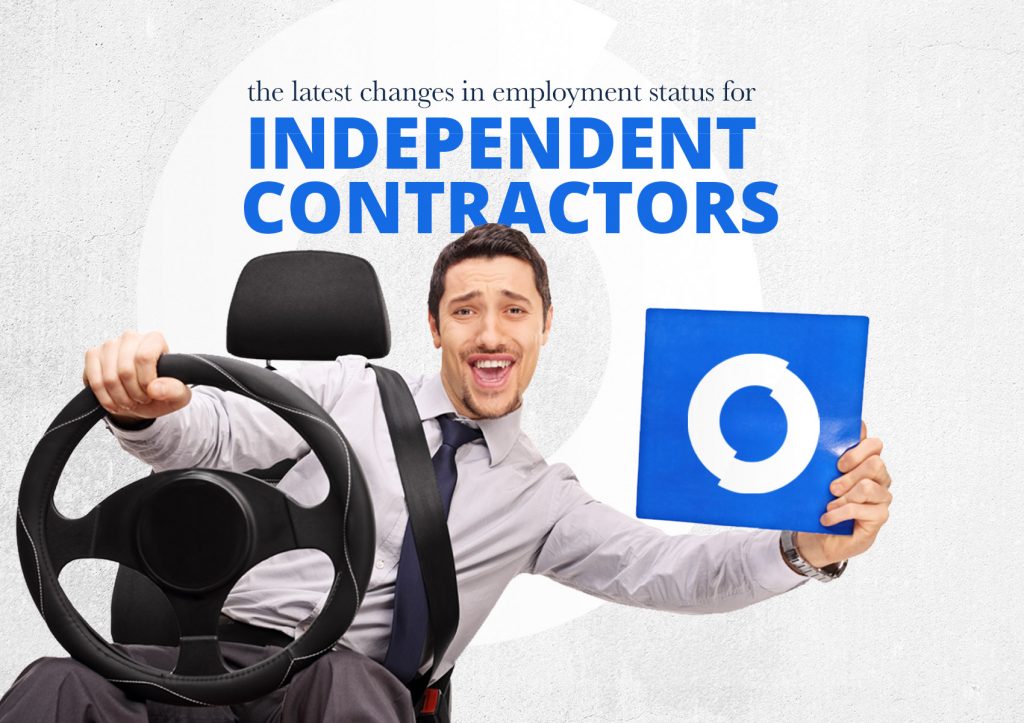From a simply mathematical perspective, your business’s costs could go down if the amount workers receive in direct compensation as independent contractors remained the same as what they took home in a paycheck. But reclassifying employees as independent contractors is a risky move that might invite a payroll tax audit and ultimately cost your business much more in penalties and fines. On the other hand, reclassifying independent contractors as employees is not risk free, either. No cause for despair, however — there actually is a correct choice, but making it requires more than a look at the bottom line.
What is the Difference Between an Employee and an Independent Contractor?
This is a question that has reached near-theological complexity, but the basic issue is control. If you control how the worker performs his or her task, that worker is probably an employee. If not, the worker is probably an independent contractor. Historically, the IRS looked at 20 factors to determine which category a worker fit into. No one factor was dispositive, and the IRS has now shifted its focus in a more holistic direction. The Department of Labor and state agencies may use slightly different criteria. Nonetheless, the twenty factors are not a bad place to start as a way to appreciate the complexity of the issue. The questions include:
- Must workers comply with instructions about when, where, and how they are to work?
- Does the employer train the worker?
- Does the success of the business depend on the services rendered by the worker or are those services ancillary?
- Must the services be performed personally by the worker?
- Does the employer hire, supervise and pay additional people assisting the worker?
- Is it a continuing relationship, or is the expectation of a continuing relationship?
- Are there set hours of work?
- Is the worker expected to work full-time?
- Is the worker expected to work on the employer’s premises?
- Does the employer set the order or sequence of tasks?
- Does the worker prepare regular oral or written reports?
- Is payment based on some period of time – by the hour, week, or month?
- Does the employer pay business or traveling expenses?
- Does the employer furnish tools or materials?
- Does the employer have the right to discharge the worker?
- Do workers have the right to end their relationship with their principals at any time without incurring liability?
- Does the worker invest in facilities that are not typically maintained by employees in order to do the work?
- Does the worker realize profits or losses?
- Does the worker have other clients?
- Does the worker make his or her services available to the general public?
A “yes” to the first 16 questions (or a “no” to the last 4) suggests an employer/employee relationship.
As the list indicates, a worker is not necessarily an independent contractor just because he or she works from home. Correct classification can become a fairly nuanced decision that requires weighing many factors. Frankly, working relationships are not static either, so the correct classification may change over time.
Why Does the Classification Make a Difference?
Employees can be much more expensive for employers than independent contractors. If a worker is an employee, the employer must withhold federal income tax and FICA taxes on the employee’s wages, pay the employer’s share of FICA taxes and the FUTA tax, state taxes and workers compensation premiums. Employees may be entitled to unpaid family leave under federal law, health insurance under the Affordable Care Act and the protection of a variety of antidiscrimination laws. Then there are additional state law protections. Under California law, for example, employees may be entitled to paid sick leave.
None of this applies to independent contractors, so employers have a considerable financial incentive to prefer them. That comes at the price of control and so may not always be appropriate. There are also stiff penalties for misclassifying workers as independent contractors.
The Penalties
The IRS penalties vary with whether the misclassification appears to be willful or not, but include a factor for the wages that should have been paid to the employee, plus back withholding. The Department of Labor can seek criminal prosecution as well as civil fines, and there are additional state fines. Both federal agencies and many states have become more aggressive in policing proper classification. An employer who is thinking about reclassifying employees as independent contractors should consider this carefully.
Reclassifying Independent Contractors as Employees
Sometimes, of course, the nature of an employment relationship changes and a worker who began as an independent contractor may now be performing tasks in a way more like an employee. An employer in that situation simply has to initiate a formal hiring process, as with any other new employee.
More likely, however, this move is a response to a mistaken classification that the employer decides to rectify in an attempt to avoid enforcement action. An employer who discovers an error may apply to participate in the IRS’s Voluntary Worker Classification Settlement Program (or VCSP) by filing IRS Form 8952 and paying a reduced penalty. An employer must execute a VCSP closing agreement, re-classify the workers prospectively and pay an amount effectively equal just over one percent of the wages paid to the reclassified workers for the past year. No interest or penalties will be due, and the employers will not be audited on payroll taxes related to these workers for prior years. In order to qualify for this program, an employer must:
- Have consistently treated the workers in the past as nonemployees,
- Have filed all required Forms 1099 for the workers for the previous three years,
- Not currently be under employment tax audit by the IRS, or within an affiliated group of businesses under audit, and
- Not currently be under audit by the Department of Labor or a state agency concerning the classification of these workers, or contesting the re-classification in court.
Although reclassification as an employee usually benefits workers, some may actually be resistant to the change, as for example, when the worker is attempting to avoid wage garnishment. This is not a sufficient reason for the employer to avoid reclassification where it otherwise appears warranted.
Another approach, where the proper classification is genuinely unclear, may be to change the nature of the working relationship prospectively so that the worker is more clearly an independent contractor. There must genuinely be a change that extends beyond having the worker formally acknowledge that he or she is an independent contractor, although that may be a sensible part of the process.
Reclassifying an Employee as an Independent Contractor
This can also be a legitimate move, but, as above, something in the nature of the working relationship must have genuinely changed. It may be the result of downsizing or the employee may request it in order to pursue other ventures. Reporting both W-2 and 1099 income for the same worker in the same year may attract IRS and Department of Labor scrutiny, however, so the employer should be prepared to defend the reclassification in the event of a payroll tax audit.
Keep in mind that this move involves terminating the employee. That may trigger any number of financial consequences, including the requirement to pay out unused sick days or accrued vacation time. The former employee may become entitled to unemployment compensation. It is also possible that he or she may simply go and find another job and become unavailable to do contract work for the former employer.
This is Too Complicated. Can’t I Just Hire Temps?
Hiring temporary workers is not a bad idea for employers who are unsure about future staffing needs. In California, however, this may not necessarily relieve an employer from the consequences of a staffing agency’s misclassification of the worker as an independent contractor. Under Assembly Bill 1897, which became law in 2014, a business that employs 25 or more workers and obtains the services of at least five workers through a labor contractor will share civil liability and legal responsibility with the labor contractor for payment of wages, safety and workers’ compensation. California employers, therefore, should perform some due diligence into the staffing agency’s employment practices.
Correctly classifying your workers can be a fairly complicated process, particularly in the light the changing nature of employment, with workers who telecommute, bring their own equipment to the office and use personal social media for work purposes. It is important to get it right, though.
Misclassifying independent contractors as employees can lead to unnecessary expenses. Misclassifying employees as independent contractors can lead to hefty penalties, fines and even criminal prosecution. Both state and federal agencies have become more diligent in examining classification issues, even in the absence of employee complaints.
Changing a worker’s status, even when the change is completely justifiable, can prompt an audit, and so should not be undertaken without a full appreciation of the potential consequences. If this is a choice your business is considering, even if that choice is prompted by an effort to rectify a past mistake, it would be worth reviewing your options with your business attorney and or human resources professional.



![Amazon’s Creative Way To Avoid Hiring Drivers As Employees [e236]](https://www.pashalaw.com/wp-content/uploads/2015/11/iStock_000061876024_Small.jpg)

![How Telecommuting Has Changed The Employee Landscape [e223]](https://www.pashalaw.com/wp-content/uploads/2015/09/iStock_000053697660_Small.jpg)

![How To Work as a Freelancer While Also Being an Employee [e150] How To Work as a Freelancer While Also Being an Employee](https://www.pashalaw.com/wp-content/uploads/2015/02/How-To-Work-as-a-Freelancer-While-Also-Being-an-Employee-.jpg)

![Starbucks Suffers from a Holiday Promotion Gone Awry [e121]](https://www.pashalaw.com/wp-content/uploads/2014/11/Starbucks-Suffers-from-a-Holiday-Promotion-Gone-Awry-e1416320892695.jpg)
![Apple Claims It Has No Access to Devices Under iOS8 [e97] Apple Claims It Has No Access to Devices Under iOS8](https://www.pashalaw.com/wp-content/uploads/2014/09/Apple-Claims-It-Has-No-Access-to-Devices-Under-iOS8-e1411395900733.jpg)
![Can the IRS Tax Employees for Getting Free Lunches? [e93] Can the IRS Tax Employees for Getting Free Lunches?](https://www.pashalaw.com/wp-content/uploads/2014/09/Can-the-IRS-Tax-Employees-for-Getting-Free-Lunches.jpg)





![Law in the Digital Age: Exploring the Legal Intricacies of Artificial Intelligence [e323]](https://www.pashalaw.com/wp-content/uploads/2023/11/WhatsApp-Image-2023-11-21-at-13.24.49_4a326c9e-300x212.jpg)
![Unraveling the Workforce: Navigating the Aftermath of Mass Layoffs [e322]](https://www.pashalaw.com/wp-content/uploads/2023/07/Untitled-design-23-300x212.png)
![Return to the Office vs. Remote: What Can Employers Legally Enforce? [e321]](https://www.pashalaw.com/wp-content/uploads/2023/01/Pasha_LSSB_321_banner-300x212.jpg)
![Explaining the Hans Niemann Chess Lawsuit v. Magnus Carlsen [e320]](https://www.pashalaw.com/wp-content/uploads/2022/10/LAWYER-EXPLAINS-7-300x169.png)
![California v. Texas: Which is Better for Business? [313]](https://www.pashalaw.com/wp-content/uploads/2021/07/Pasha_LSSB_CaliforniaVSTexas-300x212.jpg)
![Buyers vs. Sellers: Negotiating Mergers & Acquisitions [e319]](https://www.pashalaw.com/wp-content/uploads/2022/06/Pasha_LSSB_BuyersVsSellers_banner-300x212.jpg)
![Employers vs. Employees: When Are Employment Restrictions Fair? [e318]](https://www.pashalaw.com/wp-content/uploads/2022/05/Pasha_LSSB_EmployeesVsEmployers_banner-1-300x212.jpg)
![Vaccine Mandates Supreme Court Rulings [E317]](https://www.pashalaw.com/wp-content/uploads/2022/02/WhatsApp-Image-2022-02-11-at-4.10.32-PM-300x212.jpeg)
![Business of Healthcare [e316]](https://www.pashalaw.com/wp-content/uploads/2021/11/Pasha_LSSB_BusinessofHealthcare_banner-300x212.jpg)
![Social Media and the Law [e315]](https://www.pashalaw.com/wp-content/uploads/2021/10/WhatsApp-Image-2021-10-06-at-1.43.08-PM-300x212.jpeg)
![Defining NDA Boundaries: When does it go too far? [e314]](https://www.pashalaw.com/wp-content/uploads/2021/09/Pasha_LSSB_NDA_WordPress-2-300x212.jpg)
![More Than a Mistake: Business Blunders to Avoid [312] Top Five Business Blunders](https://www.pashalaw.com/wp-content/uploads/2021/06/Pasha_LSSB_Blunders_WP-1-300x212.jpg)
![Is There a Right Way to Fire an Employee? We Ask the Experts [311]](https://www.pashalaw.com/wp-content/uploads/2021/02/Pasha_LSSB_FireAnEmployee_Website-300x200.jpg)
![The New Frontier: Navigating Business Law During a Pandemic [310]](https://www.pashalaw.com/wp-content/uploads/2020/12/Pasha_LSSB_Epidsode308_Covid_Web-1-300x200.jpg)
![Wrap Up | Behind the Buy [8/8] [309]](https://www.pashalaw.com/wp-content/uploads/2020/11/Pasha_BehindTheBuy_Episode8-300x200.jpg)
![Is it all over? | Behind the Buy [7/8] [308]](https://www.pashalaw.com/wp-content/uploads/2020/09/iStock-1153248856-overlay-scaled-300x200.jpg)
![Fight for Your [Trademark] Rights | Behind the Buy [6/8] [307]](https://www.pashalaw.com/wp-content/uploads/2020/07/Fight-for-your-trademark-right-300x200.jpg)
![They Let It Slip | Behind the Buy [5/8] [306]](https://www.pashalaw.com/wp-content/uploads/2020/06/Behind-the-buy-they-let-it-slip-300x200.jpg)
![Mo’ Investigation Mo’ Problems | Behind the Buy [4/8] [305]](https://www.pashalaw.com/wp-content/uploads/2020/05/interrobang-1-scaled-300x200.jpg)
![Broker or Joker | Behind the Buy [3/8] [304] Behind the buy - Broker or Joker](https://www.pashalaw.com/wp-content/uploads/2020/04/Joker-or-Broker-1-300x185.jpg)
![Intentions Are Nothing Without a Signature | Behind the Buy [2/8] [303]](https://www.pashalaw.com/wp-content/uploads/2020/04/intentions-are-nothing-without-a-signature-300x185.jpg)
![From First Steps to Final Signatures | Behind the Buy [1/8] [302]](https://www.pashalaw.com/wp-content/uploads/2020/04/first-steps-to-final-signatures-300x185.jpg)
![The Dark-side of GrubHub’s (and others’) Relationship with Restaurants [e301]](https://www.pashalaw.com/wp-content/uploads/2015/04/When-Competition-Goes-Too-Far-Ice-Cream-Truck-Edition-300x201.jpg)
![Ultimate Legal Breakdown of Internet Law & the Subscription Business Model [e300]](https://www.pashalaw.com/wp-content/uploads/2019/05/Ultimate-Legal-Breakdown-of-Internet-Law-the-Subscription-Business-Model-300x196.jpg)
![Why the Business Buying Process is Like a Wedding?: A Legal Guide [e299]](https://www.pashalaw.com/wp-content/uploads/2019/03/futura-300x169.jpg)
![Will Crowdfunding and General Solicitation Change How Companies Raise Capital? [e298]](https://www.pashalaw.com/wp-content/uploads/2018/11/Will-Crowdfunding-and-General-Solicitation-Change-How-Companies-Raise-Capital-300x159.jpg)
![Pirates, Pilots, and Passwords: Flight Sim Labs Navigates Legal Issues (w/ Marc Hoag as Guest) [e297]](https://www.pashalaw.com/wp-content/uploads/2018/07/flight-sim-labs-300x159.jpg)
![Facebook, Zuckerberg, and the Data Privacy Dilemma [e296] User data, data breach photo by Pete Souza)](https://www.pashalaw.com/wp-content/uploads/2018/04/data-300x159.jpg)
![What To Do When Your Business Is Raided By ICE [e295] I.C.E Raids business](https://www.pashalaw.com/wp-content/uploads/2018/02/ice-cover-300x159.jpg)
![General Contractors & Subcontractors in California – What you need to know [e294]](https://www.pashalaw.com/wp-content/uploads/2018/01/iStock-666960952-300x200.jpg)
![Mattress Giants v. Sleepoplis: The War On Getting You To Bed [e293]](https://www.pashalaw.com/wp-content/uploads/2017/12/sleepopolis-300x159.jpg)
![The Harassment Watershed [e292]](https://www.pashalaw.com/wp-content/uploads/2017/12/me-2-300x219.jpg)
![Investing and Immigrating to the United States: The EB-5 Green Card [e291]](https://www.pashalaw.com/wp-content/uploads/2012/12/eb-5-investment-visa-program-300x159.jpg)
![Responding to a Government Requests (Inquiries, Warrants, etc.) [e290] How to respond to government requests, inquiries, warrants and investigation](https://www.pashalaw.com/wp-content/uploads/2017/10/iStock_57303576_LARGE-300x200.jpg)
![Ultimate Legal Breakdown: Employee Dress Codes [e289]](https://www.pashalaw.com/wp-content/uploads/2017/08/Ultimate-Legal-Breakdown-Template-1-300x159.jpg)
![Ultimate Legal Breakdown: Negative Online Reviews [e288]](https://www.pashalaw.com/wp-content/uploads/2017/06/Ultimate-Legal-Breakdown-Online-Reviews-1-300x159.jpg)
![Ultimate Legal Breakdown: Social Media Marketing [e287]](https://www.pashalaw.com/wp-content/uploads/2017/06/ultimate-legal-breakdown-social-media-marketing-blur-300x159.jpg)
![Ultimate Legal Breakdown: Subscription Box Businesses [e286]](https://www.pashalaw.com/wp-content/uploads/2017/03/ultimate-legal-breakdown-subscription-box-services-pasha-law-2-300x159.jpg)
![Can Companies Protect Against Foreseeable Misuse of Apps [e285]](https://www.pashalaw.com/wp-content/uploads/2017/01/iStock-505291242-300x176.jpg)
![When Using Celebrity Deaths for Brand Promotion Crosses the Line [e284]](https://www.pashalaw.com/wp-content/uploads/2017/01/celbrity-300x159.png)
![Are Employers Liable When Employees Are Accused of Racism? [e283] Racist Employee](https://www.pashalaw.com/wp-content/uploads/2016/12/Are-employers-liable-when-an-employees-are-accused-of-racism-300x159.jpg)
![How Businesses Should Handle Unpaid Bills from Clients [e282] What to do when a client won't pay.](https://www.pashalaw.com/wp-content/uploads/2016/12/How-Businesses-Should-Handle-Unpaid-Bills-to-Clients-300x159.png)
![Can Employers Implement English Only Policies Without Discriminating? [e281]](https://www.pashalaw.com/wp-content/uploads/2016/11/Can-Employers-Impliment-English-Only-Policies-Without-Discriminating-300x159.jpg)
![Why You May No Longer See Actors’ Ages on Their IMDB Page [e280]](https://www.pashalaw.com/wp-content/uploads/2016/10/IMDB-AGE2-300x159.jpg)
![Airbnb’s Discrimination Problem and How Businesses Can Relate [e279]](https://www.pashalaw.com/wp-content/uploads/2016/09/airbnb-300x159.jpg)
![What To Do When Your Amazon Account Gets Suspended [e278]](https://www.pashalaw.com/wp-content/uploads/2016/09/What-To-Do-When-Your-Amazon-Account-Gets-Suspended-1-300x200.jpg)
![How Independent Artists Reacted to Fashion Mogul Zara’s Alleged Infringement [e277]](https://www.pashalaw.com/wp-content/uploads/2016/08/How-Independent-Artists-Reacted-to-Fashion-Mogul-Zaras-Alleged-Infringement--300x159.jpg)
![Can Brave’s Ad Replacing Software Defeat Newspapers and Copyright Law? [e276]](https://www.pashalaw.com/wp-content/uploads/2016/08/Can-Braves-Ad-Replacing-Software-Defeat-Newspapers-and-Copyright-Law-300x159.jpg)
![Why The Roger Ailes Sexual Harassment Lawsuit Is Far From Normal [e275]](https://www.pashalaw.com/wp-content/uploads/2016/07/WHY-THE-ROGER-AILES-SEXUAL-HARASSMENT-LAWSUIT-IS-FAR-FROM-NORMAL-300x159.jpeg)
![How Starbucks Turned Coveted Employer to Employee Complaints [e274]](https://www.pashalaw.com/wp-content/uploads/2016/07/iStock_54169990_LARGE-300x210.jpg)
